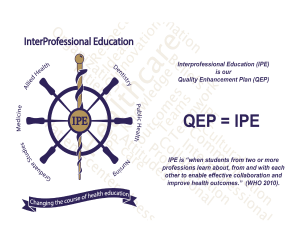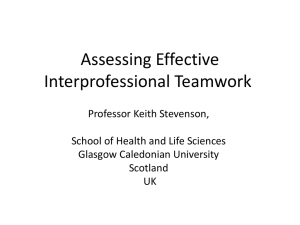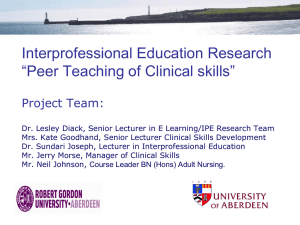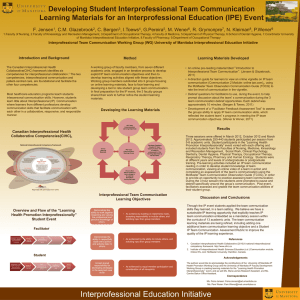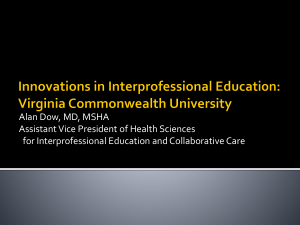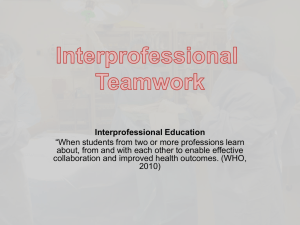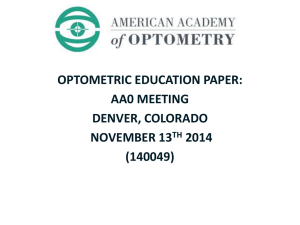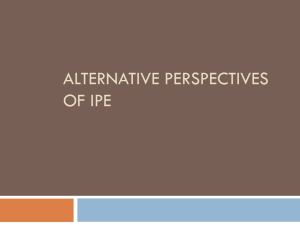PPT: Developing IPE - Midwestern University
advertisement
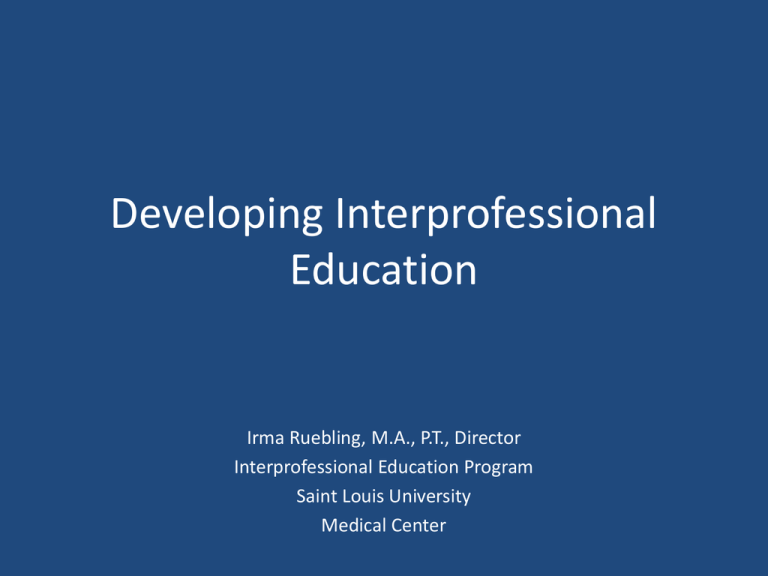
Developing Interprofessional Education Irma Ruebling, M.A., P.T., Director Interprofessional Education Program Saint Louis University Medical Center Plan for the day • Presentation followed by discussion of possible IPE at Midwestern 1. Background on why IPE is gaining such emphasis and definitions, goals, competencies 2. Content and learning experiences 3. Faculty development and program assessment 4. Wrap-up – challenges and opportunities, organizational capacity Objectives 1. Discuss the role of IPE in improving the delivery of health care services. 2. Use the terminology of IPE appropriately. 3. Identify appropriate competencies for CHS. 4. Identify possible learning experiences for CHS. 5. Identify faculty development needs to assist in successfully implementing IPE. 6. Discuss the outcomes to be measured of IPE program. 7. Discuss opportunities IPE provides. 8. Describe possible means of overcoming challenges for implementing IPE. Why IPE? • Health care system is not providing we need and deserve – to many medical errors and unsafe conditions • To provide health care that leads to optimal patient outcomes. • IPE is considered one mechanism to accomplish this goal. National Reports • Medical errors resulted from poor communication and processes of care – Institute of Medicine, To Err is Human (1999) A redesign of the health care system to include six aims: safety, patient-centered, effective, timely, efficient, and equitable Address the processes of care – Institute of Medicine, Crossing the Quality Chasm: A New Health System for the 21st Century (2001) • “All health professionals should be educated to deliver client-centered care as members of an interdisciplinary team, emphasizing evidence-based practice, quality improvement approaches, and informatics.” Institute of Medicine, Health Professions Education: A Bridge to Quality (2003). Josiah Macy Foundation • “All health professions schools have an obligation to educate future practitioners who are prepared both to assess and to meet the health needs of the public. This obligation entails…fostering greater inter-professional teamwork and collaboration.” Macy Foundation, “Revisiting the Medical School Education Mission at a time of Expansion, 2009 Morrison, G. Goldfarb, S, Lanken, PN. (2010 )Team Training of Medical Students in the 21st Century: Would Flexner Approve? Academic Medicine 85 (2), 254-259. • In the 20th Century, team members were resources for the physician as the decision maker. • In the 21st Century – team members are responsible for key decisions in the patient’s care together with the physician. • This shift demands a change in how all providers are prepared to practice. Health professionals must understand the roles and expertise of colleagues, and be able to communicate well between professions. • Health professionals must realize that the collective knowledge of the group far exceeds that of an individual. Paradigm Shift Physician Centered practice to Patient Centered practice Practitioner autonomy to Team collaboration Focus on illness & cure to Focus on health promotion Passive patient role to Involved patients & families Acute, episodic care to Care for chronic conditions Aschenbrener CA, Clearning a Path Ahead for IPE Presentation: Collaborating Across Borders II, Halifax, 2007 Institute of Medicine, Crossing the Quality Chasm (2001) What is IPE? • Definitions • Goal/Purpose • Competencies Definitions • Professional – under the same general educational governing association • Disciplinary – can be specialty within an identified profession Definitions , cont Interprofessional Multiprofessional • Shared experiences • Shared experiences • Interaction/joint decision making • No expectation of interaction or participative decisionmaking • Shared responsibility/ accountability for decisions Interprofessional Education defined • IPE occurs when 2 or more professions learn with, from, and about each other to improve collaboration and the quality of care. • Center for Advancement of Interprofessional Education, 2008 • WHO, Framework for IPE, 2011 Interprofessional Education Occurs when there is • Interaction between students and faculty of different professions AND • Goals and learning experiences lead to achieving – Performance of skills required for collaborative patient/client-centered teamwork – Understanding of and respect for the role and unique contributions of the health professions Interprofessional Practice Health care activity which requires: collaborative, interdependent use of shared expertise directed toward a unified purpose of delivering optimal patient care • Collaborative – includes concepts of shared responsibilities, shared decision-making, shared values, shared planning and intervention, and sharing of professional perspectives • Interdependent - mutual dependence rather than autonomous – arises out of common desire to address patient’s needs • D'Amour, D., M. Ferrada-Videla, et al. (2005). "The conceptual basis for interprofessional collaboration: Core concepts and theoretical frameworks." Journal of Interprofessional Care Supplement 1: 116-131. • Shared expertise - combined knowledge and skills of the team • Optimal patient care - achieving the highest level of function and self-efficacy Goal/Purpose • Based on the basic premise or value of the program • For example: – Conviction that IPE promotes better patient/client care and IP practice is best practice Example • The purpose of Interprofessional Education is to prepare students with knowledge, attitudes and skills of interprofessional practice which lead to: – – – – – Interprofessional patient/client-centered care Optimal individual patient health outcomes Improvements in community level (population) health Effective and efficient delivery of health care services Advocacy for improvement of health and health services SLU-IPE IP Competencies in Health Care • “Integrate the enactment of knowledge, skills, and values/attitudes that define working together across the professions, with other health care workers, and with patients, along with families and communities, as appropriate to improve health outcomes in specific care contexts.” • Interprofessional Education Collaborative Expert Panel. (2011). Core competencies for interprofessional collaborative practice: Report of an expert panel. Washington, D.C.: Interprofessional Education Collaborative Domains & General Competency Statements • Values/Ethics for IP Practice – Work with individuals of other professions to maintain a climate of mutual respect and shared values. • Roles and Responsibilities – Use knowledge of one’s own role and those of other professions to appropriately assess and address the healthcare needs of the patients and populations served. Interprofessional Education Collaborative Expert Panel. (2011). Core competencies for interprofessional collaborative practice: Report of an expert panel. Washington, D.C.: Interprofessional Education Collaborative Domains & General Competency statements • Interprofessional Communication – Communicate with patients, families, communities, and other health professionals in a responsive and responsible manner that supports a team approach to the maintenance of health and the treatment of diseases. • Teams and Teamwork – Apply relationship-building values and the principles of team dynamics to perform effectively in different team roles to plan and deliver patient-/populations centered care that is safe, timely, efficient, effective and equitable. Interprofessional Education Collaborative Expert Panel. (2011). Core competencies for interprofessional collaborative practice: Report of an expert panel. Washington, D.C.: Interprofessional Education Collaborative Developing Competencies • Useful to identify core themes around which to develop competencies for IPE – Based on concepts and values of IPE, mission of institution and professional programs • Identify specific competencies. – May be iterative – a continuing working document Develop IPE Competencies Based on 5 domains of SLU-IPE core curriculum • • • • • Interprofessional Practice Patient-Centered Care Wellness Patient Safety and Quality Care Social Justice Example: Interprofessional Practice • Competency: Participate in effective collaboration with health professionals in developing and implementing plans of care to achieve optimal health outcomes. • Objective: Discuss unique contributions of each health professional for care of patient • Learning Activity: Study one page description of each profession. Group interview of member of profession. Reflect on professional contributions in case discussions including IP Grand Rounds. Also reflect on how the team working together impacted the patient’s care. SLU-IPE Example: Wellness • Competency: Recognize a population health perspective that encompasses the ability to assess the health needs of a specific population, implement and evaluate interventions to improve the health of that population. • Objective: Identify and recommend clinical prevention services based upon a patient’s age, gender, and risk factor status. • Learning activity: IP team projects and presentations on health promotion/education activity for specific populations including how each professional contributes. SLU-IPE Stop – Think – Reflect • How does IPE fit with the mission of the college and University? • What areas are covered in your programs that could benefit from becoming part of the IPE program? • What student competencies would you see as important outcomes of IPE? Development • Learning experiences • Teaching methods Types of IPE Programs • An IPE day or workshop • IPE Seminar • IPE Clinical Experience • IPE didactic course • IPE embedded throughout program Formative Concept • Interprofessionality: – An approach to care and education where educators and practitioners collaborate synergistically to provide an integrated and cohesive answer to the needs of the client/family/population IPE to enhance learner outcomes Interdependent with Collaborative practice to enhance patient care outcomes D'Amour, D. and I. Oandasan (2005). "Interprofessionality as the field of interprofessional practice and interprofessional education: An emerging concept." Journal of Interprofessional Care Supplement 1: 8-20. Interprofessional Education Collaborative Expert Panel. (2011). Core competencies for interprofessional collaborative practice: Report of an expert panel. Washington, D.C.: Interprofessional Education Collaborative Statement of Premises/Principles • Statements based on definitions, purpose, competences. • Statements of values and beliefs about IPE Premises/Values of Beliefs • • • • Examples IPE should occur as early as possible in the professional curriculum Embedding IPE experiences within and throughout existing curricula allows aspects of patient-centered care and IP team practice to be an expected part of professional practice IP collaborative practice occurs with deliberate planning and implementation of learning and practice, not by good will, intent, desire, or chance alone IPE must have interactive learning experiences, didactic and experiential, that include critical reflection SLU-IPE Operationalizing Concepts and Values The development of IPE curriculum, courses, and other learning activities is a collaboration between faculty of various health professions • designing and implementing activities for IP student learning • retaining joint responsibility and accountability for IP student learning outcomes Operationalizing Concepts and Values Student learning in IPE is defined as occurring when courses and other learning experiences meet criteria of interaction leading to achievement of the IP learning outcomes. Criteria for IPE Learning Experiences • Students and faculty represent multiple health professions • Objectives include demonstrating a level of achievement related to interprofessional competencies • Content relating to interprofessional competencies is included • Assignment includes interprofessional team work • Student evaluation includes an assessment of growth in interprofessional competence SLU-IPE Selecting Content for IPE • Identify topics that are best covered with an IP approach as IPE has been defined. – Currently in professional curricula – Not in professional curricula but should or would be good to be cover – Would benefit for interprofessional discussions and actions Selected Content • Examples: – Roles and responsibilities of various health professionals – Principles and development of teamwork – Health care system – Health promotion – Health care ethics – Evidenced-based practice – Interprofessional practicum – Interprofessional grand rounds Interprofessional Team Seminar • Introduction to communication and patient safety • Discussion of IP teams and professional training & roles and responsibilities in patient care • Case-based discussion including standardized patient simulations – Contributions of each profession – Discussion of priorities for assessment and care plan – Imbedding in the cases issues of cultural differences, health literacy, patient safety, socioeconomic concerns, ethical issues in the cases, social determinants of health SLU-IPE Teaching Methods • Lecture combined with team and small group discussion in break-out sessions • Small group discussion sessions of 20-30 students • Students are divided into IP teams of 4-5 for in-class discussions and out-of class projects • Students produce team reports of in-class discussions • Critical reflection assignments on Grand Rounds, certain readings and videos Stop – Think – Reflect • What do you see as curricular and teaching/ learning issues for IPE? • How would teaching in IPE differ from teaching now in single professional courses? • What teaching strategies do you think should be used in IPE experiences? Your Thoughts • What do you think are your faculty development needs for implementing and sustaining an IPE program? • What is the best way for you to engage in these faculty development activities? Faculty Development Possible topics: Commitment to the value of IPE and IP collaborative practice Knowledge of scope of practice of the professions Effective teamwork skills Teaching and managing large classes Interactive learning Small–group facilitating Use of critical reflection Faculty Development • Methods: – Do and reflect – Self-directed learning – Facilitated workshops – Conferences – Mentors and consultants – In-house formal and informal discussions • Steinert, Y. (2005). "Learning Together to Teach Together: Interprofessional Education and Faculty Development." Journal of Interprofessional Care 1(Supplement): 60-75. Assessment Plan • • • • • Assumptions Assessment is based on learning outcomes and objectives Include assessment of knowledge, attitudes, and skills Student learning outcomes or competencies drive the research questions Research is multi-method Research is longitudinal SLU-IPE Curriculum Management • Interprofessional Teaching & Learning Team – Determines student learning outcomes – Oversees course development through course teams – Develops flow chart linking outcome with objectives and learning activities – Evaluates results of assessments for curricular changes SLU- IPE Assessment Management • Assessment Team – Oversees the assessment process to assure student learning outcomes are included – Identifies preliminary research questions based on student development of attitudes, knowledge, and skills related to the student learning outcomes – Continuously monitors development of new and on-going research questions SLU-IPE Assessment Implementation • Assessment Project Teams – Refine specific research purpose and questions related to a project – Determine the type of assessment: quantitative, qualitative – Develop the research protocol – Conduct reliability and validity testing – Participate in data collection, analysis procedures and dissemination of results SLU-IPE SLU-IPE Assessment Blueprint Learning outcomes Attitudes Knowledge Skills Research purpose Research Research question(s) Methods Evaluation of results Attitudes Learning Outcomes 1. Value (or significance) of the IP team in providing patient care. 2. Demonstrate how to contribute effectively to the development of care plans which are responsive to the clients’ needs and diverse needs of the community at large. Research purpose – To assess changes in students’ attitudes and perceptions about learning with students in various health professions and about working in collaborative teams SLU-IPE Attitudes: Research questions 1. What are the attitudes and perceptions about IP learning and teamwork of students with no formal education in IPE? 2. What changes occur in student attitudes and perceptions about IP learning and teamwork from: – prior to and after the first IPE course; – after their last IPE practicum course; – and after one year of professional experience in their chosen health career? SLU-IPE Attitudes: Research Methods • Questionnaire: Readiness for IP Learning Scale (Parsell, McFayden) and University of West England IP Questionnaire (Pollard) followed by focus group concerning inconsistent items and confirmation of results • Analysis: Remark scan, SPSS, descriptive and interferential statistics, factor analysis, followed by qualitative analysis identifying themes. SLU-IPE Knowledge Learning Outcomes 1. 2. Discuss the unique contribution of each health care profession for the care of clients. Refer the care of the patient to appropriate health professional based on the scope of practice and unique expertise of the profession. Research Purpose – To assess changes in students’ ability to identify the best choice health professional to implement a procedure or intervention in the patient’s care plan. SLU-IPE Knowledge: Research questions Does the student’s ability to identify the most appropriate health professional to provide a particular service needed in a specific case improve from prior to and after the first IPE course; after their last IPE practicum course; and after one year of professional experience in their chosen health career? SLU-IPE Knowledge: Research Methods • Questionnaire consisting of case and questions regarding the most appropriate health professional to provide needed services followed by focus groups to clarify discrepancies in responses. • Analysis: Remark scan, SPSS, descriptive and interferential statistics, followed by qualitative analysis identifying themes. SLU-IPE Summary • The focus of the evaluation is on outcomes assessment throughout the education program including postgraduation components. • This assessment process allows for multiple projects in various stages. • Projects may build off of each other. • As a comprehensive program the assessment – is longitudinal, – includes quantitative and qualitative studies, and – encompasses assessment of attitudes, knowledge, and skills. Organizational Capacity • Leadership AND Grassroots Commitment • Centralized coordination – Infrastructure – Creation of designated Program or Center – Existence of a general plan – mandate • Funding and facilities Faculty & Staff Engagement Across Health Professions Faculty and clinical staff from different professions who value IP collaboration and share a vision and common goals work together to – Co-create curriculum and clinical programs – Develop knowledge and skills of IP interaction – Take an active role in the scholarship agenda – Focus on patient-centered care Leadership Commitment • Centralized operation, coordination and support • Infrastructure fosters time to develop IP activities, incentives to engage in IP endeavors, and integration across professions • Find solutions to issues of scheduling as well as faculty and staff recruitment • Provide appropriate physical facilities, technology and other resources Interprofessional Education (IPE) Program Organization Assistant VP, Health Sciences Executive Advisory Committee IPE Director IPE Program Coordinator IPE Assistant Director IPE Assistant Director IPE Practicum Team IPE Post-Baccalaureate Curriculum Track IPE Practicum Community Sites Interprofessional Team Seminars (IPTS) Interprofessional Grand Rounds IPE Teaching and Learning Team IPE Fr-Entry Course Coordinator(s) IPE Course Faculty Teams IPE 110: Intro IP Health Care IPE Assessment Team IPE 350: HC Systems/Health Promo IPE Assessment Project Teams IPE 420: App Decision Making in IP Practice IPE 460: Evidence Based Practice Updated 6/1/11 IPE 490: Integrated IP Practicum Existence of a Plan • Strategic Plan for development, evaluation, and sustainability – Shared vision of IPE and IPP – Explicit philosophy of IPE that permeates the organization – Existence of a plan for implementing goals of IPE IPE Policies • Examples: – – – – Faculty participation Use of funds Student enrollment Student academic policies Funding and Facilities • Space for teaching – large group, small group • Administrative space • Funding for Faculty and Staff Shared Challenges of the faculty • Faculty development – Learning to communicate as a teaching team • Large class size – new to all faculty • Scheduling of classes and teaching team meetings • Engaging new faculty Opportunities for Faculty Involved in IPE • • • • • IP collaboration amongst faculty Learning more about other professions Shared research New & strengthened friendships Newer faculty learn from more experienced faculty with whom they team teach Opportunities for Students Involved in IPE • Opportunity for students to experience best practice – Modeling of IP teamwork – Enhanced collaboration – Improved student awareness of IP teams • Enhanced focus on patient/client centered care & improved health outcomes • Increased student comfort level with IP teams Development of Culture of IPE or IPP • Indicators: – Vision of IP endeavor is commonly understood – Faculty members across professions are engaged – Administrative support – funding, facilities as well as staff, faculty and student recognition – Full integration in professional education and practice – Included in recruitment activities for faculty, students, and clinical staff – Incorporated into uni-professional courses including clinical experiences Challenges • State-of-the-art for research in IPE and IP practice outcomes is limited and considered weak in methodology. • Uncertainty regarding potential for reimbursement model for interprofessional collaborative practice The Opportunity of Interprofessional Health Care • Health professionals working at the top of their knowledge and skill – Enhanced staff motivation and satisfaction • Working as team providing the right care for the patient when it is needed – Enhanced patient motivation and satisfaction • Being part of change in delivery of care that can accomplish optimal health outcomes IPE Best Practices • Begin IPE early in the health professional program • Experiences occur throughout the health professional program • Include interaction among students and working in teams • Include didactic, practical and clinical experiences Always keep the vision in the forefront. It is about improving patient care.
